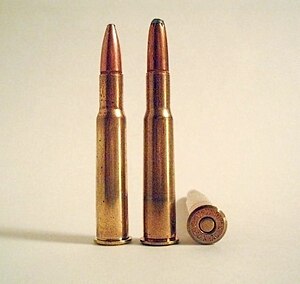.30-40 Krag
| .30-40 Krag | ||||||||||||||||||||||||
|---|---|---|---|---|---|---|---|---|---|---|---|---|---|---|---|---|---|---|---|---|---|---|---|---|
 | ||||||||||||||||||||||||
| Type | Rifle | |||||||||||||||||||||||
| Place of origin | United States | |||||||||||||||||||||||
| Service history | ||||||||||||||||||||||||
| In service | 1892–1903 | |||||||||||||||||||||||
| Used by | United States | |||||||||||||||||||||||
| Production history | ||||||||||||||||||||||||
| Designed | early 1890s | |||||||||||||||||||||||
| Produced | 1892–present | |||||||||||||||||||||||
| Specifications | ||||||||||||||||||||||||
| Case type | Rimmed, bottleneck | |||||||||||||||||||||||
| Bullet diameter | .308 in (7.8 mm) | |||||||||||||||||||||||
| Land diameter | .301 in (7.6 mm) | |||||||||||||||||||||||
| Neck diameter | .338 in (8.6 mm) | |||||||||||||||||||||||
| Shoulder diameter | .423 in (10.7 mm) | |||||||||||||||||||||||
| Base diameter | .457 in (11.6 mm) | |||||||||||||||||||||||
| Rim diameter | .545 in (13.8 mm) | |||||||||||||||||||||||
| Rim thickness | .064 in (1.6 mm) | |||||||||||||||||||||||
| Case length | 2.314 in (58.8 mm) | |||||||||||||||||||||||
| Overall length | 3.089 in (78.5 mm) | |||||||||||||||||||||||
| Case capacity | 58.0 gr H2O (3.76 cm3) | |||||||||||||||||||||||
| Maximum pressure (C.I.P.) | 47,137 psi (325.00 MPa) | |||||||||||||||||||||||
| Maximum CUP | 40,000[1] CUP | |||||||||||||||||||||||
| Ballistic performance | ||||||||||||||||||||||||
| ||||||||||||||||||||||||
| Source(s): Hodgdon [2] | ||||||||||||||||||||||||
The .30-40 Krag, also known as the .30 U.S. and .30 Army, was a rifle cartridge developed in the early 1890s to provide the U.S. armed forces with a smokeless powder cartridge suited for use with modern small-bore repeating rifles to be selected in the 1892 small arm trials. Since the cartridge it was replacing was the .45-70 Government, the new cartridge was considered small-bore at the time. The rifle ultimately selected for use by the Army was the Krag–Jørgensen, formally adopted as the M1892 Springfield. The cartridge was also used in the M1893, M1895, M1897, and M1900 Gatling guns.[3][4][5][6]
History and development[edit]
Though the U.S. Navy and Marine Corps had adopted limited numbers of smokeless powder and bolt-action rifles, the .30-40 was the first cartridge adopted by the US Army that was designed from the outset for smokeless powder. It was patterned after .303 British, to which it is very similar geometrically.[7] After a brief experiment with a 230-grain bullet loading, the .30 Army loading was standardized in 1894 using a 220-grain (14 g) metal-jacketed round-nose bullet with 40 gr (2.6 g) of nitrocellulose powder. This loading developed a maximum velocity of 2,000 ft/s (610 m/s) in the 30-inch (760 mm) barrel of the Krag rifle,[8] and 1,960 ft/s (600 m/s) in the 22-inch (560 mm) barrel of the Krag carbine.
The rimmed .30-40 round was also known as .30 Army or .30 U.S. Although the .30-40 Krag was the first smokeless powder round adopted by the U.S. military, it retained the "caliber-charge" naming system of earlier black powder cartridges, i.e. a .30-caliber bullet propelled by 40 grains (2.6 g) of smokeless powder. The first use of a smokeless powder round by Winchester was a single shot in 30-40, and it was one of only three rounds for which the 1895 Winchester lever action, introduced in 1896, was originally chambered.[9]
From the outset, the .30-40 cartridge proved popular for hunting and was chambered in a variety of firearms. In 1899, a Krag in .30-40 caliber was used to shoot the world-record Rocky Mountain elk. The record stood until the latter half of the 20th century.
In October 1899, after reviewing the experiences of the Spanish–American War, U.S. Army ordnance authorities developed a new loading for the .30 Army used in the Krag rifle, in an attempt to match the ballistics of the 7×57mm Mauser cartridge employed by Spanish forces in that conflict. The new loading increased the muzzle velocity in the rifle version of the Krag to 2,200 ft/s (670 m/s) at 45,000 psi. However, once the new loading was issued, reports of cracked locking lugs on service Krags began to surface. In March 1900, the remaining stocks of this ammunition (some 3.5 million rounds) were returned to the arsenals, broken down, and reloaded back to the original 2,000 ft/s (610 m/s) specification.[citation needed]
In 1903, after recommendations from the infantry Small Arms Board, the U.S. Army formally adopted a higher-velocity .30-caliber replacement for the .30-40 or .30 Army cartridge. The new cartridge was designated by its year of adoption, the .30-03.[citation needed]

See also[edit]
- List of rifle cartridges
- Table of handgun and rifle cartridges
- .30-06 Springfield
- .30-30 Winchester
- 7 mm caliber other cartridges of similar size.
References[edit]
- ^ Saami pressures. (n.d.). Retrieved May 3, 2023, from https://leverguns.com/articles/saami_pressures.htm
- ^ ".30-40 data at Hodgdon Online". Archived from the original on 2007-11-11. Retrieved 2007-08-01.
- ^ Laststandonzombieisland. (2020, February 7). Great War Gatling Guns?. laststandonzombieisland. https://laststandonzombieisland.com/2020/02/07/great-war-gatling-guns/
- ^ Association, N. R. (n.d.). Men and guns of the 1900 China relief expedition. An Official Journal Of The NRA. https://www.americanrifleman.org/content/men-and-guns-of-the-1900-china-relief-expedition/
- ^ Colt 1897 gatling gun rifle 30-40. Rock Island Auction Company. (n.d.). https://www.rockislandauction.com/detail/61/1270/colt-1897-gatling-gun-rifle-3040
- ^ Colt U.S. navy mark II model 1900 gatling gun with carriage. Rock Island Auction Company. (n.d.-b). https://www.rockislandauction.com/detail/83/1219/colt-us-navy-mark-ii-model-1900-gatling-gun-with-carriage
- ^ "A Tale of Three .30s". 7 March 2019.
- ^ Johnson, Melvin M. Jr. (1944). Rifles and Machine Guns. New York: William Morrow & Company. p. 384.
- ^ History of Winchester Firearms, 1866–1992, Thomas Henshaw, p 44-45
- Barnes, Frank C; Skinner, Stan (Ed.) (1965, 1969, 1972, 1980, 1985, 1989, 1993, 1997, 2000, 2003). Cartridges of the World (10th ed.). Iola, Wisconsin: Krause Publications. ISBN 0-87349-605-1.
- .30-40 Krag by Chuck Hawks
- Hornady Handbook of Cartridge Reloading vol I, Sixth Edition; Book by Hornady Mfg Co, 2003
- Ordnance Department, United States (1917). Handbook of the Gatling Gun, Caliber .30. Washington, D.C.: Government Printing Office.
- Cartridge Dimensions at Steve's Pages


 French
French Deutsch
Deutsch